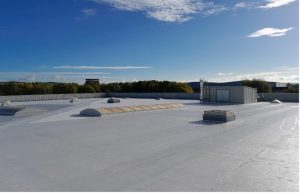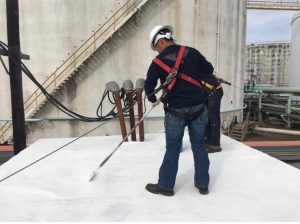More news
- Focus on the global coatings market: Global coatings market outlook
- Innovative coatings mitigate effects of deepening climate change
- View from the UK: Navigating chemical policy and sustainability
- Focus on adhesives: Unveiling unbreakable bonds – Testing redefines physical strengt...
- Focus on adhesives: Henkel and Covestro collaborate for sustainability of engineered wood ...

Chloe Hirst, Belzona, discusses the benefits of using a cool roof coating to combat the ongoing cycle of higher temperatures caused by global warming leading to more and more air conditioning use, which has been shown to damage the environment
In recent Solar Reflectance Index (SRI) testing, results showed that the cool roof coating Belzona 3111 (Flexible Membrane) exhibited high solar reflectance properties with an average* SRI of 99.4%. Considering the vicious cycle of increased global temperatures leading to an increased use of air conditioning, which exacerbates the problem further, polymeric technology like this plays a valuable role in mitigating this damaging process.

Figure 1. Cool roof coating reduces internal temperature of structures
What is a Cool Roof?
A cool roof strongly reflects sunlight and also cools itself by efficiently emitting any heat that has been absorbed. To measure this effect, SRI testing examines a material’s solar reflectance and thermal emissivity. The SRI is a value that combines these figures; it is used to indicate how hot a material will likely become when its surface is exposed to solar radiation. The SRI is defined on a scale of 0 – 100, with standard black being 0 and standard white being 100.
The air conditioning global warming trap
Materials with lower SRI values are more likely to absorb a high fraction of the incoming solar energy and become hotter in the sun. A fraction of this absorbed energy is conducted into buildings and structures. With increased internal temperatures, this increases the requirement for air conditioning.
Hand-in-hand with this, this process incurs a considerable carbon footprint. According to research from scientists from NREL and Xerox PARC, in 2022, air conditioning was responsible for 3.94% of global greenhouse gas emissions. This is the equivalent of 1,950 million tonnes of carbon dioxide released annually – and this figure is set to rise.
As global temperatures continue to increase, this will inevitably lead to a rise in the use of air conditioning. The research predicts increases of 14% in the hottest climate studied (Chennai, India) and of 41% in the mildest (Milan, Italy) by 2050.
Describing the damaging nature of this process, the research describes how: ‘This causes a self-reinforcing pattern that must be addressed through improved cooling, both for the health of humankind and the stabilisation of the climate.’
READ MORE:
Considering the predicted increase in use of air conditioning, cool roof coatings such as Belzona 3111 (Flexible Membrane) have an important part to play in helping to minimise this expected growth.
Belzona 3111 (Flexible Membrane) is a cold-applied liquid coating specially designed for long-term roof protection. With outstanding waterproofing and weatherproofing properties, this single-component, water-based roof coating will bond strongly to all types of roofing materials, following even complex roof contours. It is certified by the British Board of Agrement and ETA-Danmark (European Technical Assessment). The isocyanate-free system has also been proven to provide excellent protection of roofs for in excess of 25 years.
When the SRI testing was conducted in accordance with ASTM E1980-11, Belzona 3111 (Flexible Membrane) in white achieved an average SRI of 99.4%.

Figure 2. Belzona 3111 (Flexible Membrane) cool roof coating
This high SRI figure reflects how this system is optimised for rejecting solar radiation. This means that when a roof is coated in Belzona 3111 (Flexible Membrane), a significant reduction in internal temperature can be achieved.
This figure can be used to demonstrate compliance with some building codes if the measured Solar Reflectance and Thermal Emittance figures do not comply on their own.

Figure 3. Application of roof waterproofing membrane
Reduce costs and environmental impact with polymeric technology
Commenting on the recent test result, Technical Coordinator, Isaac Atkinson said: “Belzona 3111 (Flexible Membrane) has an important role to play in helping to alleviate the destructive cycle of increased air conditioning usage. By coating roofs with this cool roof system, this will help to reduce internal temperatures, therefore, asset owners can significantly reduce the need to use air conditioning. As a result, this will enable asset owners to not only make significant financial savings, but to also reduce their carbon footprint as well.”
For more information about Belzona 3111 (Flexible Membrane), please click here: www.belzona.com/en/products/3000/3111.aspx
*Average figure based on SRI calculated in low, medium and high winds







